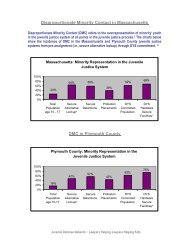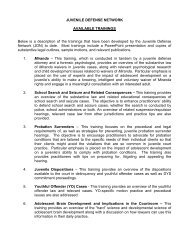States rethink 'adult time for adult crime' - the Youth Advocacy Division
States rethink 'adult time for adult crime' - the Youth Advocacy Division
States rethink 'adult time for adult crime' - the Youth Advocacy Division
Create successful ePaper yourself
Turn your PDF publications into a flip-book with our unique Google optimized e-Paper software.
We <strong>the</strong>n made our way to <strong>the</strong> scanner. After removing all metal objects —<br />
including a belt and a stray dry-cleaning tag with a staple — I put on earphones<br />
and a helmet that was shaped like a birdcage to hold my head in place. The lab<br />
assistant turned off <strong>the</strong> lights and left <strong>the</strong> room; I lay down on <strong>the</strong> gurney and,<br />
clutching a panic button, was inserted into <strong>the</strong> magnet. All was dark except <strong>for</strong> a<br />
screen flashing hypo<strong>the</strong>tical crime scenarios, like this one: “John, who lives at<br />
home with his fa<strong>the</strong>r, decides to kill him <strong>for</strong> <strong>the</strong> insurance money. After<br />
convincing his fa<strong>the</strong>r to help with some electrical work in <strong>the</strong> attic, John arranges<br />
<strong>for</strong> him to be electrocuted. His fa<strong>the</strong>r survives <strong>the</strong> electrocution, but he is<br />
hospitalized <strong>for</strong> three days with injuries caused by <strong>the</strong> electrical shock.” I was told<br />
to press buttons indicating <strong>the</strong> appropriate level of punishment, from 0 to 9, as<br />
<strong>the</strong> magnet recorded my brain activity.<br />
After I spent 45 minutes trying not to move an eyebrow while assigning<br />
punishments to dozens of sordid imaginary criminals, Marois told me through<br />
<strong>the</strong> intercom to try ano<strong>the</strong>r experiment: namely, to think of familiar faces and<br />
places in sequence, without telling him whe<strong>the</strong>r I was starting with faces or<br />
places. I thought of my living room, my wife, my parents’ apartment and my twin<br />
sons, trying all <strong>the</strong> while to avoid improper thoughts <strong>for</strong> fear <strong>the</strong>y would be<br />
discovered. Then <strong>the</strong> experiments were over, and I stumbled out of <strong>the</strong> magnet.<br />
The next morning, Owen Jones and I reported to René Marois’s laboratory <strong>for</strong><br />
<strong>the</strong> results. Marois’s graduate students, who had been up late analyzing my brain,<br />
were smiling broadly. Because I had moved so little in <strong>the</strong> machine, <strong>the</strong>y<br />
explained, my brain activity was easy to read. “Your head movement was<br />
incredibly low, and you were <strong>the</strong> harshest punisher we’ve had,” Josh Buckholtz,<br />
one of <strong>the</strong> grad students, said with a happy laugh. “You were a researcher’s dream<br />
come true!” Buckholtz tapped <strong>the</strong> keyboard, and a high-resolution 3-D image of<br />
my brain appeared on <strong>the</strong> screen in vivid colors. Tiny dots flickered back and<br />
<strong>for</strong>th, showing my eyes moving as <strong>the</strong>y read <strong>the</strong> lurid criminal scenarios.<br />
Although I was only <strong>the</strong> fifth subject to be put in <strong>the</strong> scanner, Marois emphasized<br />
that my punishment ratings were higher than average. In one case, I assigned a 7<br />
where <strong>the</strong> average punishment was 4. “You were focusing on <strong>the</strong> intent, and <strong>the</strong><br />
o<strong>the</strong>rs focused on <strong>the</strong> harm,” Buckholtz said reassuringly.
















